| |
The Village Vibe
Khalid Hasan lays out the challenges and opportunities of rural marketing
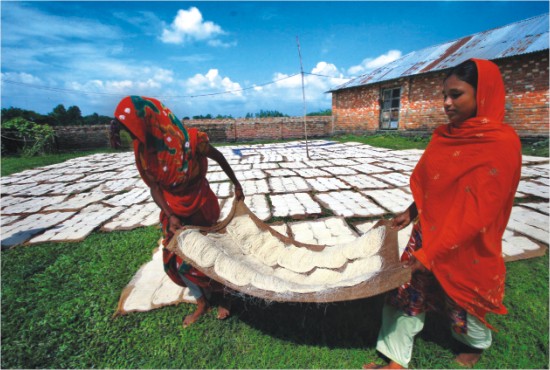
Shafiq Islam/Driknews
Introduction
With more than 70% of its population residing in the rural areas, it would not be wrong to describe Bangladesh as a giant village. It is, therefore, important that marketers understand the challenges and dynamics of the rural market. Considering that 64% of the rural population are below the age of thirty and 77% of the total population were born after the War of Liberation (i.e. after 1971), it can be safely concluded that it is the youth of today who, through their tireless efforts, are fuelling the engine of growth and keeping our nation on the path of steady development despite the recent global economic recession. This fact should have a definite impact on communication and nation branding.
The economy is in a state of constant flux with lifestyles and life skills changing continuously, propelling the country to ever greater heights. In such a fluid situation, it is imperative to keep on steering the country in the right direction and the marketers can play an important role in this regard.
Marketers must recognize the distinct nature of the rural market and refrain from replicating urban-oriented strategies in rural areas. Since communication is a process whereby messages, ideas, feelings and facts are conveyed in order to forge a common understanding, marketers must be attuned to the aspirations and thought-processes of the rural audience and also be cognizant of the prevailing social structure. Pradeep Kashyap, the Indian rural marketing guru, in his book Rural Marketing, has explained how the rural environment is different from the urban and, therefore, communicating with potential customers in rural areas in a proper and effective manner is a major challenge for corporate marketers. The majority of the advertisements designed by corporate masters are largely urban-oriented and their use in rural areas shows little or no consideration for the values and sensitivities of the rural audience and may lead to a negative perception in the minds of villagers about urban media planners and advertisers. Simply looking at some rural pictures is not enough; corporate advertisers need to develop a different mindset and fresh insight (Kashyap 2006).
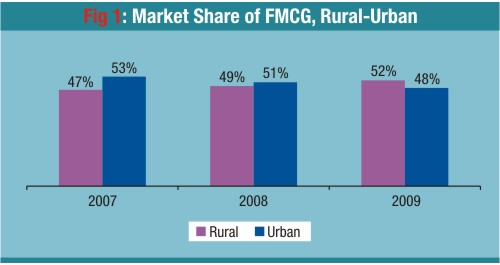
Rural market dynamics: impact of overseas remittance
In a recent report, the World Bank estimated that a sustained growth of around 7.5% per annum is needed for Bangladesh to become a middle-income country within a decade. A look at the GDP figures of the last 5 years reveals that the economy has been growing at a fairly steady rate. Foreign exchange remittance (by migrant workers and NRBs) has also been increasing at a healthy pace (it was almost US$10billion in the current fiscal); this has had a positive impact on infrastructure development and consumer demand especially in the rural areas which are the major recipients of overseas remittances. Despite global economic recession, the growth of demand in the rural market, especially for FMCG (fast moving consumer goods), has been phenomenal. What is significant is that the rural market's share of FMCG has been increasing steadily over the years and it has already outstripped urban demand in the current calendar year (Fig. 1, Nielsen retail audit). This is a clear indication of the rapid increase in effective demand of the rural consumers compared to that of their urban counterparts. It is, therefore, imperative for market researchers to analyse and understand the nature and dynamics of the fast-changing consumption patterns of the rural consumers. A major factor contributing to their steadily increasing purchasing power is the phenomenal increase in overseas remittance that has registered an almost six-fold increase over the last decade (Fig. 2). The nation owes a debt of gratitude to the migrant workers and NRBs whose hard-earned earnings have contributed significantly towards poverty-alleviation of the nation in general and of the rural masses in particular. A concomitant positive effect of such huge remittance inflows is a significant reduction in income inequality between the rural and urban populations.
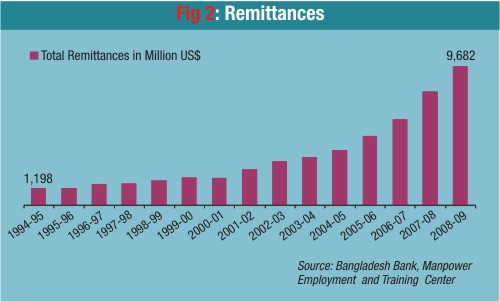
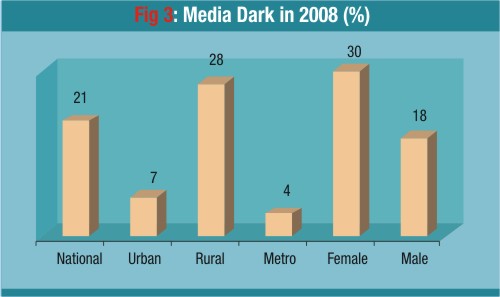
Challenges to rural communication and increased reach of mass media
Following are some of the major bottlenecks hampering effective rural communication in a developing country like Bangladesh:
-Low literacy levels;
-Poor media reach: media-dark (zero media exposure) and media-gray (poor media exposure) segments;
-Different dialects (with widely dissimilar phonetics) spoken in different districts (e.g. the dialects of Chittagong and, say, Bogra are poles apart);
-Dearth of adequate and accurate information;
-Paucity of adequate infrastructure and skilled manpower in the ICT sector;
According to the Neilson Media and Demographic Survey of 2008 (BMDS 2008), 21% of the total population, 30% of the female population, 28% of the rural population and 7% of the urban population have no access to any form of mass media and can, therefore, be characterised as "media-dark" (Fig. 3). It is, however, heartening to note that television access has increased tremendously from 1994 to 2008 (Fig. 4): from 31% to 68% of the total population, 24% to 59% of the rural population and 64% to 89% of the urban population. A simple extrapolation of these percentage figures will show how significant this has been, in absolute terms, for the rural audience. Based on a 70/30 rural/urban population ratio, this means that, in 1994, for every 19 urbanites with access to TV, there were only 17 in the rural areas; whereas, in 2008, for, for every 27 urbanites, there were 41 rural inhabitants who had access to TV!
Mobile phone subscription has also grown at a phenomenal rate in recent years. Its importance in rural areas cannot be overemphasised since this is a device which has multifarious uses other than merely conversing. It is used by farmers to obtain price information for their produce, by patients in remote areas to access medical advice, for round-the-clock news updates, as a source of music and entertainment, etc.
Private FM channels such as Radio Today, Radio Furti, Radio Amar, etc. have also not been lagging behind. They have already created large audience pools among the rural youth population who can also access these programs through their mobile phones.
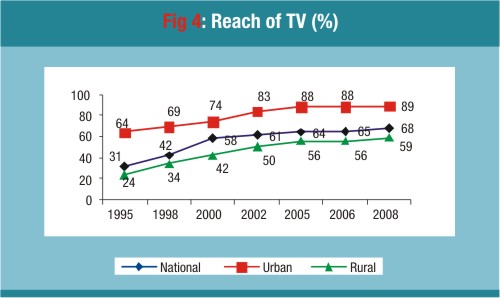
Understanding the audience
Various market studies (e.g. Hasan 2002) reveal that consumers have their own set of idiosyncrasies and dogmas which are deeply rooted in their cultures. We can, thus, state with conviction that what would work very well for one set of consumers may not work at all for another, even in the same geographical area, because of different ethnic, religious and financial backgrounds. Therefore, before devising a marketing strategy for brand promotion, it is imperative for all marketers to understand the psyche of the target audience.
In this respect, the rural audience may be divided into three distinct categories:
-The educated, upwardly mobile, middle-income, media-savvy category, with high aspirations and considerable purchasing power, who are in many ways comparable to the urban population;
-The segment of the rural youth who have attained "medium level" ( SSC or HSC) education and who have got some exposure to urban lifestyle (frequent visits to the urban areas, access to modern amenities such as TV, mobile phone, motor cycle, etc.);
- The ultra-poor illiterate masses who are inaccessible to the mass media (media-dark);
Buying Process and the Predominant Role of the Rural Youth
Pradeep Kashyap (Rural Marketing) has rightly pointed out that the rural people may be illiterate, but they are by no means unintelligent. Due to increasing media reach, aggressive advertising campaigns and frequent inter-personal communication (which is comparatively more common in the rural areas), rural consumers are quite familiar with the various products and services available in the market.
Basically, the buying process involves:
-Awareness of products and services through TV, radio and, to a lesser extent, newspapers; the youth, who are often the first-generation literates, assimilate more from such exposure because of their enthusiasm and education.
-Through frequent visits to urban areas (for entertainment, treatment of elders or employment), they are exposed to various brands of products and services.
-They, then, share their ideas with their peers and/or rural opinion leaders.
-These informal discussions help the rural consumers to reach well-informed decisions on, not only product, but also brand selection.
- The marketers/advertisers, while devising their campaign, should avoid random or "hypothetical" assumptions about the rural consumers and carefully consider the following:
-What do our rural population use (lifestyle)?
-What do they buy and why (brand specific)?
-The extremely important role of the "youth opinion leaders" in the buying process.
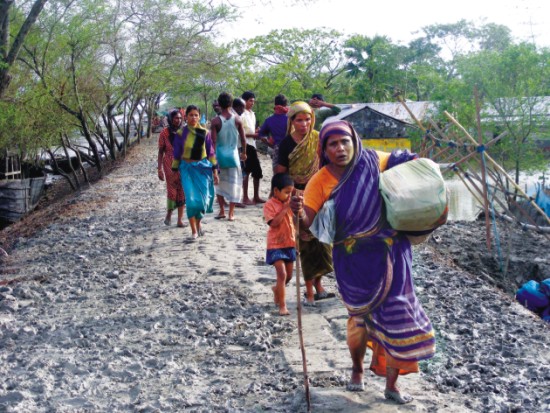
Tomzid Mollick/Driknews
Brand consciousness
The Nielsen retail audit data reveals a significant growth of brand consciousness among the rural consumers. This is manifested by the fact that there have been considerable shifts in consumer preferences from, not only loose (non-brand) to brand products but also from one brand to another. Rural consumers are increasingly opting for popular brands which have acquired wide exposure as a result of extensive advertising campaigns (for example, Nokia, Lux, Grameen Phone, Sunsilk, Parachute, Coke, Pepsi, Igloo, Radhuni, Pure, etc.).
Women empowerment and lifestyle
Another important aspect that marketers can ignore only at their peril is the undeniable role of women in rural communication. Lifting of taboos on female education, greater access to employment (e.g. RMG sector), participation in adult literacy and birth-control programs and involvement in micro credit programs of institutions such as Grameen Bank and Brac have greatly contributed to women empowerment in rural Bangladesh. Several studies bear this out. Hasan 2002 concludes that micro credit has had a highly positive impact on women empowerment. In a recent World Economic Forum (WEF) report, Bangladesh ranked 139th in gender balance, faring significantly better than India which ranked 153rd. Gender equality is reflected by the fact that fertility rate has halved (from 6 to 3) during the last two decades the steepest fall anywhere in the world except China. It is now below India's and far below Pakistan's. Rural marketers must therefore ensure that women's lifestyles, aspirations and expectations get prime consideration while developing any communication initiative.
Rural communication and corporate social responsibility (CSR)
Side by side with product promotion, it is important that corporate planners devote a part of their advertisement/communication budget for CSR purposes (promotion of social values, environment protection, sponsorship of rural sports and cultural activities etc.). Corporations should undertake such activities not only for altruistic purposes but also for sound business reasons since such social exposure has a way of reaping dividends in the long run. Some of our major local business houses and multinationals (Square, DB Bank, Beximco, Unilever, BAT, Grameen Phone etc.) are already quite active in this regard but more companies need to join this trend.

Shafiq Islam/Driknews
Non-conventional media
Apart from the usual media avenues, there are many non-conventional media vehicles which are rooted in the history and traditions of our rural culture:
-Wall paintings are becoming increasingly popular among marketers for promoting products among the rural consumers.
-Folk media consisting of folk songs, folk dances, and jatras (rural theatre)- These are immensely popular in rural areas, especially among the women and children. The marketers may use these vehicles to enhance their reach and penetration.
-Puppet shows a traditional and popular mode of entertainment among rural people which can be used for brand promotion.
-Paintings on the backs of rickshaws are quite common all over Bangladesh. Marketers can use this medium more effectively.
-Uthan (front yard) communication It is a common practice in rural Bangladesh for communicators to hold informal meetings in the uthans of village homes for dissemination of information. The Ministry of Health and Family Welfare (MOHFW) has achieved significant success this way.
-Haats (rural markets) In rural Bangladesh, haats , which sit 2-3 days a week on specified days, not only play a vital role in marketing and shopping but also serve as a place where people communicate and interact.
-Melas (fairs) are an important feature of our rural life.
-Mobile film vans some organisations like Social Marketing Company (SMC) and MOHFW use mobile film vans for promoting their products and services. The programs are designed carefully so that they contain both entertainment (dramas, songs, dances, etc.) and advertisements.
The above media vehicles present marketers with excellent opportunities to carry their messages across to the rural people.
Conclusion
In summing up, we would like to draw the attention of the corporate marketers to the fact there is an untapped market at the bottom of the pyramid (BOP) which constitutes 40% of the total population most of whom either reside in the rural areas or have got strong roots therein (for example, female garments workers regularly visit their village homes although they work in the urban/suburban areas). In order to tap this virgin market, marketers must devise appropriate strategy for effective rural communication and for that they think and act locally. Fitting urban modules in the rural structure is not going to work. Advertising agencies should not ignore the values, customs and heritage of the rural people. Simply put, the messages that the marketers transmit must be worded in a way that the rural audience can readily identify with.
Reference:
BMDS 2008; Nielsen's Bangladesh Media and Demographic Survey 2008
Hasan 2002: Khalid Hasan; Behavior Change Model 2002
Kashyap 2006; Pradeep Kashyap; Rural Marketing 2006
Dr. Khalid Hasan is the Managing Director of Nielsen Bangladesh and also the Treasurer of AmCham Bangladesh.
|







